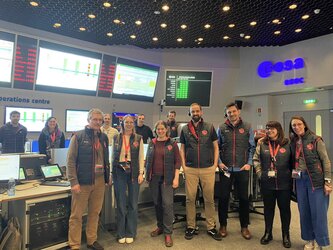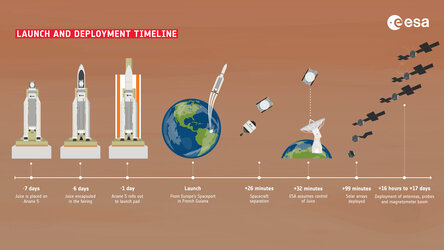
Waking up Juice
Thank you for liking
You have already liked this page, you can only like it once!
It takes a while for a new mission to wake up after the rigours of launch, but before it’s fully in flight configuration it’s still exposed to the harsh realities of space. During this critical period, known as the ‘Launch and Early Orbit Phase’ or ‘LEOP’, teams at ESA’s mission control in Darmstadt, Germany, have to work fast to establish contact with the fledgling mission, and ensure its solar arrays are correctly powering the mission.
Once ESA’s Jupiter Icy Moons Explorer, Juice, separates from its Ariane 5 rocket, there will be two key moments to look out for. ‘Acquisition of Signal’ is the moment ground stations pick up a mission’s first words, or ‘telemetry’. ESA’s New Norcia ground station in Australia is expected to be the first to hear from Juice. You can watch the moment the station gets in touch with Juice with Estrack Now, as well as all the stations in ESA’s extended network across the globe.
Next, is solar array deployment. Juice’s huge, 85-square metre solar arrays will open out just like a complex unfolding origami box. Once Juice is power positive, ground control will declare “We have a mission”!
Follow @esaoperations for live updates from the heart of ESA mission control.
-
CREDIT
ESA - European Space Agency -
LICENCE
ESA Standard Licence
-
Closed captions available Captions and subtitles are available (automatically generated by YouTube) - select your language using the YouTube player controls. A non-YouTube version is available using the 'download' and 'source' buttons below.
-
Documentary
-
-
-
-
-
-

Stage set: Juice dress rehearsal complete

Juice engineering model arrives at ESA mission control

Juice launch and deployment timeline

Juice’s lunar-Earth flyby: the movie


